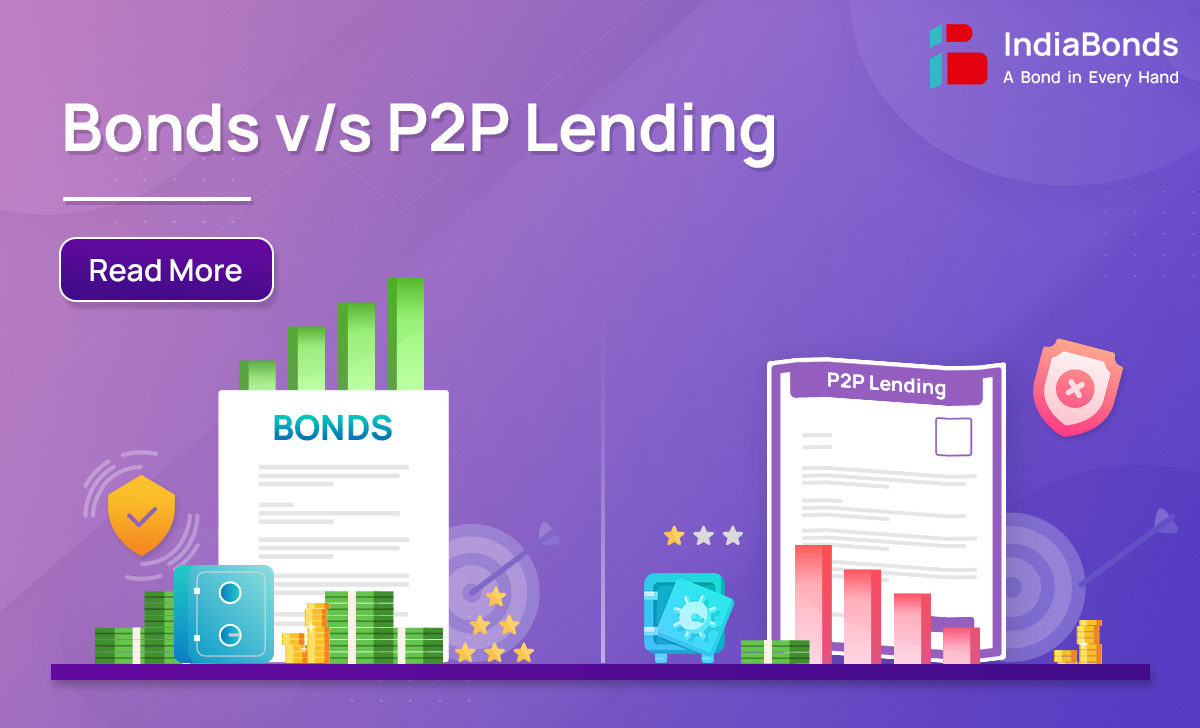Bonds vs P2P Lending

Introduction
If a retail investor looking for fixed-income investment options in India does a simple Google search of peer 2 peer lending vs bonds, they may find themselves inundated with misleading online information. This information tends to favor P2P lending and often portrays bonds negatively, creating a sense of apprehension. This skewed perspective fails to present a comprehensive view of the digital lending landscape in India, including the significant rise in default rates and the decline of the P2P industry in China. In this article, we aim to dispel this financial stereotype that mixes fixed-income investing with alternative investments. We will address the contentious issue of ‘P2P lending vs bonds,’ guiding you through the selection process in this new era of investment.
What is P2P Lending?
Peer-to-Peer lending has garnered substantial attention in recent times, largely attributed to the proliferation of online platforms facilitating the connection between borrowers and individual lenders. Within this framework, investors have the opportunity to directly extend loans to individuals or small enterprises, with the expectation of receiving interest in return. P2P lending serves as a means through which borrowers can access funding that might otherwise remain beyond their reach, especially when contrasted with conventional lending sources such as banks. Notably, this platform undertakes comprehensive credit assessments of borrowers to ascertain their creditworthiness. This evaluation culminates in the assignment of a risk score, a composite derived from their credit history (CIBIL, etc.)and pertinent additional criteria.
P2P – The Untold Story
Enthralled by the promise of substantial returns, Ramesh withdrew Rs 80,000 from his matured fixed deposits, intending to provide loans to borrowers holding low credit ratings. These lending platforms meticulously evaluate borrowers based on their repayment history, income, and various other criteria, categorizing them into grades ranging from ‘A’ to ‘F.’ The higher-rated grades offer returns of 10 to 12 percent, while the riskiest ‘F’ grade entails a 20 percent interest rate.
Ramesh distributed the sum of Rs 80,000 among 15 borrowers. Initially, he experienced prompt monthly payments. However, as time progressed, certain borrowers began to delay their payments, and a subset even defaulted for several consecutive months. After the span of a year, Ramesh was able to recuperate only Rs 10,000, leaving the remaining amount unrecovered.
According to moneycontrol, complaints against digital lending apps more than doubled to 1,062 in FY23, as revealed by the finance ministry in July 2023. The National Crime Records Bureau (NCRB) reported 14,007 cyber fraud cases, including online app-related frauds, in 2021. Despite government and RBI crackdowns, these issues persist. Usually, individuals who resort to borrowing on P2P platforms are those unable to secure loans from traditional banks due to their limited creditworthiness or extremely modest earnings. According to reports, approximately 20-30 %of borrowers joining P2P platforms lack any credit record. Typically, they face challenges in obtaining loans from both banks and non-banking finance companies (NBFCs). Experts highlight that the default rate on P2P platforms typically ranges between 2-7 percent. Therefore, individuals should consider accounting for both the default rates and other factors such as tax rates and inflation when calculating their potential returns.
The China Story
The P2P lending market in China, renowned as the world’s largest, has been experiencing swift closures primarily attributed to instances of defaults, abrupt shutdowns, and funds being frozen. According to a publication in the International Review of Economics & Finance Journal, Chinese P2P lending platforms exhibited an astonishing default rate of 87.2% based on 2019 data. In the year 2018 alone, a staggering 4,334 P2P lending platforms collapsed following regulatory intervention in China. The fundamental reason behind the downfall of China’s P2P sector stemmed from the transformation of nearly all P2P platforms into shadow banks, offering principal guarantees. As the count of P2P platforms escalated, each platform felt a heightened incentive to provide principal guarantees in response to intense competition, enticed by the potential for financial misconduct in an environment with limited regulatory oversight.
Food for thought!
Before investing their hard-earned moolah in P2P lending, it is crucial for retail investors to pose specific and probing questions:
- When it comes to the difference between bonds and P2P lending, one shouldn’t forget the notion of ‘the underlying asset’ – Bonds in general are backed by collateral, with government bonds being reinforced by sovereign guarantee. Is there any collateral involved in P2P lending, and if so, what does it entail?
- Traditional investment choices, such as bonds, have well-established operations; however, they could necessitate extra funds for expansion or other purposes, as explicitly outlined in the Information Memorandum. Can a lender comprehend the financial needs of a lower-rated borrower, or seek insight into the business requirements of P2P borrowers, which conventional banks may struggle to fulfill?
- Is it inherently a liquid instrument? What occurs with the invested capital in the event of a catastrophe such as Covid, prompting a mass withdrawal by lenders? Can all investors reclaim their capital? Does diversifying the capital amongst 100 borrowers’ strategy work in such times? Are there any safeguards established by P2P platforms for this scenario? Unlike bonds, which are listed on exchanges and possess a vibrant trading market, thereby satisfying the liquidity requirement.
- P2P follows a direct lending business model, meaning that the lender bears the entire risk. There is no guarantor for the interest or principal. The P2P platform’s role is pivotal – does it guarantee capital recovery in the event of payment defaults? Bonds have debenture trustees to protect bondholders’ interests. How do P2P platforms ensure their investors’ interests are safeguarded?
- Lastly, why would an individual consistently borrow at rates of 18-20%? In a scenario where the economy experiences high interest rates, borrowers may need to establish elevated rates to outpace the market. However, this can lead to an unsustainable situation for them. In such cases, the question arises: How feasible would it be for their business to support these financial needs? Can it be maintained over time?




Is there a comparison between bonds and P2P lending?
The origins of this story trace back to when P2P lending was labeled as a fixed-income product, which is highly debatable. Bonds, on the other hand, boast a history spanning three centuries, with the first bond issuance dating back to 1694. Despite experiencing both highs and lows inherent to any financial asset class, bonds have demonstrated resilience, longevity, and a capacity to generate income for individuals.
The emergence of P2P lending can be linked to the aftermath of the 2008 financial crisis, a period that eroded trust in traditional banking systems. Although P2P and bonds share certain attributes, like interest rates and functionality, they diverge in critical ways. Both promise fixed returns over designated time frames, concluding with capital repayment at the term’s end. However, it’s important to recognize that P2P ventures should ideally be classified as an Alternative Investment asset class, distinct from the established Fixed-Income asset class typified by bonds. The hallmark of fixed-income assets such as bonds is their ability to deliver predictable and consistent returns, a quality not always evident in the realm of P2P lending, as demonstrated above.
In today’s world, being financially literate is a deliberate choice. One cannot afford to disregard these new-age financial tools entirely, yet it is imperative to conduct thorough research prior to investing. Investors should concentrate on crafting an optimal portfolio with a suitable blend of asset classes, conceptualize financial objectives, and establish an appropriate portfolio composition aligned with their goals (such as building emergency funds, etc.) and not get swayed by alluring returns. Once these prerequisites are met, one can consider venturing into such investment avenues. It is essential to scrutinize the borrower’s profile, assess their intentions, offer support to MSMEs and small entrepreneurs in need of financial assistance, and evaluate the platforms’ gross NPAs. Engage in due diligence; refrain from relying solely on anecdotal information from colleagues or unverified WhatsApp messages. Till then, stay vigilant and make informed financial decisions. For more such content log on to IndiaBonds.com
FAQs
Q. Which offers better returns, Bonds or P2P lending?
A. The potential returns from P2P lending can be alluring, often higher than traditional bonds. However, they come with higher risks and are not as secure as bonds.
Q. Are Bonds safer than P2P lending?
A. Generally, bonds are considered safer due to their backing by governments or established companies. P2P lending carries higher default risks as it involves individual borrowers.
Q. What are the risks associated with P2P lending?
A. P2P lending involves the risk of borrower defaults, platform insolvency, and lack of regulation. Conducting comprehensive research prior to making an investment is of paramount importance.
Q. Do Bonds and P2P lending offer fixed income?
A. Bonds usually provide fixed interest payments, ensuring stable income. P2P lending returns can vary, and there’s a possibility of not receiving expected payments.
Q. Are Bonds or P2P lending more liquid?
A. Bonds are generally more liquid as they can be bought or sold in secondary markets. P2P lending investments might have limited secondary market options, impacting liquidity.
Disclaimer: Investments in debt securities/ municipal debt securities/ securitised debt instruments are subject to risks including delay and/ or default in payment. Read all the offer related documents carefully.



















































